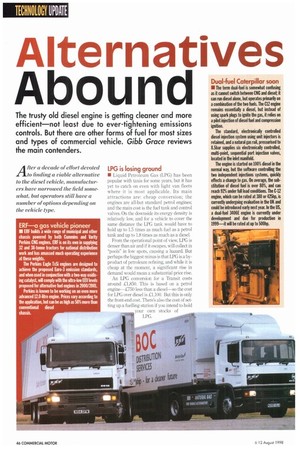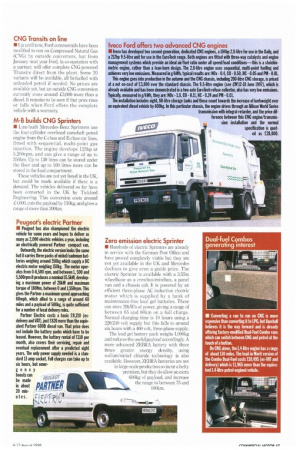TECHNOLOGY UPDATE
Page 48

Page 49

If you've noticed an error in this article please click here to report it so we can fix it.
Alternatives Abound
The trusty old diesel engine is getting cleaner and more efficient—not least due to ever-tightening emissions controls. But there are other forms of fuel for most sizes and types of commercial vehicle. Gibb Grace reviews the main contenders.
After a decade of effort devoted to finding a viable alternative to the diesel vehicle, manufacturers have narrowed the field somewhat, but operators still have a number of options depending on the vehicle type.
ERF—a gas vehicle pioneer
ERF builds a wide range of municipal and other chassis powered by both Cummins and Varity Perkins CHC engines. (RI is on its own in supplying 32 and 38-tonne tractors for national distribution work and has amassed much operating experience at these weights.
The Perkins Eagle Tdi engines are designed to achieve the proposed Euro-3 emission standards, and when used in conjunction with a two-way oxidising catalyst, will comply with the ultra-low EEV levels proposed for alternative fuel engines in 2000/2001.
Perkins is known to be working on an even more advanced 12.0-litre engine. Prices vary according to the application, but can be as high as 50% more than conventional diesel chassis.
LPG is losing ground
• Liquid Petroleum Gas (LPG) has been popular with taxis for some years, but it has yet to catch on even with light van fleets where it is most applicable. Its main attractions are: cheap conversion; the engines are all-but standard petrol engines; and the main cost is the fuel tank and control valves. On the downside its energy density is relatively low, and for a vehicle to cover the same distance the LPG tank would have to hold up to 1.5 times as much fuel as a petrol tank and up to 1.8 times as much as a diesel.
From the operational point of view, LPG is denser than air and if it escapes, will collect in "pools" in low spots, causing a hazard. But perhaps the biggest minus is that LPG is a byproduct of petroleum refining, and while it is cheap at the moment, a significant rise in demand would mean a substantial price rise.
An LPG conversion for a Transit costs around 11,850. This is based on a petrol engine-050 less than a diesel—so the cost for LPG over diesel is 11,1(10. But this is only the front-end cost. There's also the cost of setting up a fuelling station if you intend to hold your own stocks of LPG.
Dual-fuel Caterpillar soon • The term dual-fuel is somewhat confusing as it cannot switch between CNC and diesel; IL Can run diesel alone, but operates primarily on a combination of the two fuels. The C12 engine remains essentially a diesel. but instead of using spark plugs to ignite the gas, it relies on a pilot injection of diesel fuel and compression ignition.
The standard, electronically controlled diesel injection system using unit injectors is retained, and a natural gas rail, pressurised to 8.5bar supplies six electronically controlled, multi-point, sequential port injection valves, located in the inlet manifold.
The engine is started on 100% diesel in the normal way, but the software controlling the two independent injections systems, quickly effects a change to gas. On average, the substitution of diesel fuel is over 8E, and can reach 92% under full load conditions. The C-12 engine, which can be rated at 380 or 425tip, is currently undergoing evaluation in the UR and could be introduced early next year. In the US, a dual-fuel 3406E engine is currently under development and due for production in 1999—it will be rated at up to 500hp.
CNG Transits on line
• Up until now, Ford commercials have been modified to run on Compressed Natural Gas (CNG) by outside converters, but from January next year Ford, in co-operation with a partner, will offer complete CNG-powered Transits direct from the plant. Some 20 variants will he available, all bi-fuelled with unleaded petrol if needed, No prices are available yet, but an outside CNG conversion currently costs around ,Z3,000 more than it diesel. It remains to he seen if that price rises or falls when Ford offers the compleie vehicle with a warranty.
M-B builds CNG Sprinters
• Line-built Mercedes-Benz Sprinters ustthe four-cylinder overhead camshaft petrol engine from the C-class and E-class car lines, fitted with sequential, multi-point gas injection. The engine develops 125hp at 5,200rpm, and can give a range of up to 250km. Up to 130 litres can be stored under the floor and up to 160 litres more can be stored in the load compartment.
These vehicles are not yet listed in the UK, but could be made available if there is a demand. The vehicles delivered so far have been converted in the UK by Tickford Engineering. This conversion costs around £4,000. cuts the payload by 110kg, and gives a range of more than 300km.
Peugeot's electric Partner
• Peugeot has also championed the electric vehicle for some years and hopes to deliver as many as 2,000 electric vehicles a year, including an electrically powered Partner compact van.
Outwardly, the electric version looks the same but it carries three packs of nickel/cadmium batteries weighing around 350kg which supply a DC electric motor weighing 150kg. The motor operates from 0-6,500 rpm, and between 1, 500 and 5,500rpm it produces a nominal15.5kW, developing a maximum power of 28kW and maximum torque of 180Nm, between 0 and 1,550rpm. This gives the Partner a maximum speed approaching 60mph, which allied to a range of around 60 miles and a payload of 500kg, is quite sufficient for a number of local delivery roles.
Partner Electric costs a basic £9,210 (exdelivery and VAT), just £820 more than the equivalent Partner 600D diesel van. That price does not include the battery packs which have to be leased. However, the battery rental of £110 per month, also covers their servicing, repair and eventual replacement after a predicted eight years. The only power supply needed is a standard 13 amp socket. Full charges can take up to six hours, but emergency boosts can
in about PEI.IGEOt -
be made
20 minPARTNER
Iveco Ford offers two advanced CNG engine
• Iveco has developed two second-generation, dedicated CNC engines, a 104hp 2.8-litre for use in the Daily, and a 212hp 9.5-litre unit for use in the EuroTech range. Both engines are fitted with three-way catalysts and engine management systems which provide an ideal air/fuel ratio under all speed/load conditions—this is a stoichiometric engine, rather than a lean-bum design. The 2,8-litre engine uses sequential, multi-point fuelling and achieves very low emissions. Measured in g/kWh, typical results are: NOx 0.4, CO 0.50, NC 0.05 and PM -0.01.
This engine goes into production in the autumn and the CNG chassis, including 200-litre CNG storage, is priced at a net on-cost of £3,800 over the standard chassis. The 9.5-litre engine (see CM12-18 June 1997), which is already available and has been demonstrated in a two-axle EuroTech refuse collector, also has very low emissions. Typically, measured in g/kWh, they are: NOx 1.0, CO 0.11, NC 0.24 and PM 0.01.
The installation includes eight, 80-litre storage tanks and these count towards the increase of kerbweight over an equivalent diesel vehicle by 800kg. In this particular chassis, the engine drives through an Allison World Series transmission with integral retarder, and the price difference between this CNG engine/transmission installation and the normal specification is quoted as £28,000.
Zero emission electric Sprinter
• Hundreds of electric Sprinters are already in service with the German Post Office and have proved completely viable but, they are not yet available in the UK and Mercedes declines to give even a guide price. The electric Sprinter is available with a 3.55m wheelbase as a crewbusiminibus, a panel van and a chassis cab. It is powered by an efficient three-phase AC induction electric motor which is supplied by a bank of maintenance-free lead gel batteries. These can store 29kWh of power, giving a range of between 65 and 80km on a full charge. Normal charging time is 10 hours using a 220/240 volt supply but this falls to around six hours with a 400 volt, three-phase supply. The lead gel battery pack weighs 1,000kg and reduces the useful payload accordingly. A more advanced ZEBRA battery with three times greater energy density, using sodium/nickel chloride technology is also available. However, ZEBRA batteries are not in large-scale production so incur a hefty premium, but they do allow an extra 600kg of payload, and increase the range to between 75 and 100km. Dual-fuel Combos generating interest • Converting a van to run on CNG is more expensive than converting it to LPG, but Vauxhall believes it is the way forward and is already offering factory modified Dual-Fuel Combo vans which can switch between CNG and petrol at the touch of a button.
On CNG alone, the 1.4-litre engine has a range of about 130 miles. The lead-in Merit version of the Combo Dual-Fuel costs £10,495 (ex-VAT and delivery) which is £1,965 more than the equivalent 1.4-litre peirol-engined vehicle.












































































































